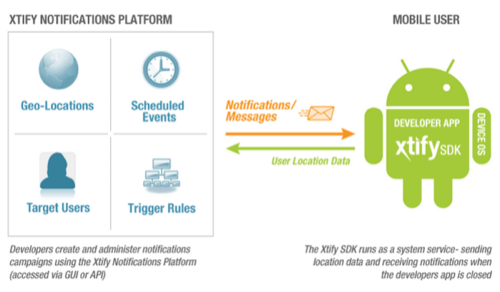Xtify’s recently launched geo-messaging platform is demonstrated in a new YouTube video created by Motorola, makers of popular Android devices like the Motorola Droid smartphone. The Xtify geo-location platform and its associated SDK (software development kit) was announced at February’s Mobile World Congress in Barcelona. With the SDK, developers can integrate geo-targeted messaging into their applications, starting with Google’s Android mobile operating system and later arriving to the Blackberry, Symbian, Windows Mobile and iPhone operating systems.

Prepare for your mobile apps to get a lot more pushy.
Xtify: “Geo-Relevant” Messaging for Android
With Xtify-enabled applications, messages can be customized and sent to users based on their exact location. For example, local search and discovery applications could send you messages about businesses close by. Shoppers could be sent mobile coupons as they walked through the mall. Restaurant guide applications could ping you with recommendations about top-rated nearby establishments. Travel apps could pop up interesting facts about landmarks, historical sites and other points of interest as you went sightseeing.
While obviously marketers are going to glom onto the opportunities a local-aware messaging platform like this offers, Xtify’s SDK, as you can see in the examples above, could be used for more engaging mobile messages than just coupons, ads and geo-spam.

Why on Android First?
It’s not surprising that Xtify launched first on Android instead of iPhone. Just prior to the platform’s debut, Apple announced that location-aware ads would not be allowed in all of its mobile applications. Likely concerned with the potential for abuse, Apple posted a notice to their developer center reading:
“If you build your application with features based on a user’s location, make sure these features provide beneficial information. If your app uses location-based information primarily to enable mobile advertisers to deliver targeted ads based on a user’s location, your app will be returned to you by the App Store Review Team for modification before it can be posted to the App Store.”
Android has no such restrictions due to its nature as a more open platform where apps don’t have to go through a review process prior to arriving in the app marketplace. That should help Xtify get a head start since developers can simply take the SDK and run with their ideas without fear that their app will be rejected.
The Demo Video
A few weeks ago at the CTIA Wireless conference, Motorola had the chance to demo the Xtify geo-aware push notification platform for Android and recorded a video of that experience. Motorola Program Manager Randy Ksar has just now posted the demo to the Motodev blog here. As the video shows, notifications can be completely customized and then tracked on the backend, displaying what notification was sent, when, to who and what actions were taken after it was sent. (Skip to minute 4:10 if you just want to see the message demo on the Android phone itself).
Xtify can also be integrated with existing content management systems or CRM systems, or it can run independently. On the platform, developers can create campaigns, trigger rules, run scheduled events, create personalized, dynamic messages, set geo-fences (e.g. apps know when you’re at “home” versus at “work” and adapt accordingly) and access advanced reporting and analytics for evaluating a message’s success and the campaign’s ROI.
According to Xtify’s VP of business development, Joshua Schiffman, the company has several very large media companies that are close to launching, but is not permitted to announce who and when at this time. He does note, however, that Xtify has seen interest from some “online and mobile publishers with tens of millions of users each month and location-relevant content,” including those running movie booking services, restaurant review services, city event finders and travel services. They’ve also fielded inquiries from some big-box retailers, national brands, mid-size companies with a few million users and traditional publishers looking to deliver news updates.
Image credit on original post: FoneHome.








